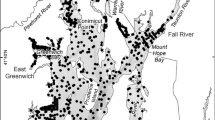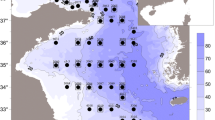Abstract
The community composition of benthic macroinvertebrates from 870 estuarine sites was examined in order to either confirm or challenge established boundaries of biogeographical provinces along the Gulf of Mexico and western Atlantic coasts of the United States. The objective was two-fold: (1) to demarcate boundaries that separate dissimilar fauna in the Gulf of Mexico, and (2) to compare the Gulf of Mexico biogeographically with other well-known provinces. We segmented the coastline into grid cells with dimensions of 1° latitude and 2–4° longitude. Using the descriptive techniques of cluster analysis and nonmetric multidimensional scaling, we determined the similarities in benthic community composition between sites within grid cells in the Gulf of Mexico and compared the biotic ordinations to natural habitat characteristics such as salinity, sediment type, and depth. We then evaluated the overall community composition within each grid cell in the Gulf of Mexico and established whether or not similarities existed between adjacent grid cells. In this manner, we confirmed that an east–west gradient existed in estuarine benthic community composition along the Gulf of Mexico coast. This information was combined with our previous work in the western Atlantic coast to discern biogeographical provinces. Based on cluster analyses and an analysis of endemic benthic species the following provinces are proposed: (1) the Virginian province, from Cape Cod, Massachusetts to Wilmington, North Carolina, (2) the Gulf of Mexico, from Rio Grande, Texas to Cape Romano, Florida, and (3) south Florida, south of latitude 26° N. The region encompassing South Carolina, Georgia and northern Florida represents a transitional area between temperate and tropical provinces.
Similar content being viewed by others
References
Briggs, J. C., 1974. Marine Zoogeography. McGraw-Hill, New York: 475 pp.
Brown, J. H. & A. C. Gibson, 1983. Biogeography. The C.V. Mosby Co., St. Louis: 643 pp.
Calder, D.R., 1992. Similarity analysis of hydroid assemblages along a latitudinal gradient in the western North Atlantic. Can. J. Zool. 70: 1078-1085.
Cerame-Vivas, M. J.& I. E. Gray, 1966. The distributional pattern of benthic invertebrates of the continental shelf off North Carolina. Ecology 47: 260-270.
Clarke, K. R. & R. M. Warwick, 1994. Change in marine communities: an approach to statistical analysis and interpretation. Natural Environment Research Council, U.K.: 144 pp.
Coomans, H. E., 1962. The marine mollusk fauna of the Virginian area as a basis for defining zoogeographical provinces. Beaufortia 9: 83-104.
Cox, C. B. & P. D. Moore, 1993. Biogeography: an Ecological and Evolutionary Approach. Blackwell Scientific Publications, Oxford: 326 pp.
Diaz, J. M., 1995. Zoogeography of marine gastropods in the southern Caribbean: a new look at provinciality. Carib. J. Sci. 31: 104-121.
Ekman, S., 1953. Zoogeography of the Sea. Sidgwick and Jackson, London: 417 pp.
Engle, V. D. & J. K. Summers, 1999a. Latitudinal gradients in benthic community composition in western Atlantic estuaries. J. Biogeogr. 26(5): 1007-1023.
Engle, V. D. & J. K. Summers, 1999b. Refinement, validation and application of a benthic condition index for northern Gulf of Mexico estuaries. Estuaries 22: 624-635.
Forbes, E., 1856. Map of the distribution of marine life. In Johnston, A. K. (ed.), The Physical Atlas of Natural Phenomena. W. and A.K. Johnston, Edinburgh and London, plate no. 31.
Golikov, A. N., M. A. Dolgolenko, N. V. Maximovich & O. A. Scarlato, 1990. Theoretical approaches to marine biogeography. Mar. Ecol. Prog. Ser. 63: 289-301.
Gosner, K. L., 1971. Guide to identification of marine and estuarine invertebrates. Wiley-Interscience, New York: 693 pp.
Hall, C. A., 1964. Shallow-water marine climates and molluscan provinces. Ecology 45: 226-234.
Hayden, B. P. & R. Dolan, 1976. Coastal marine fauna and marine climates of the Americas. J. Biogeogr. 3: 71-81.
Hedgpeth, J. W., 1953. An introduction to the zoogeography of the northwestern Gulf of Mexico with reference to the invertebrate fauna. Publ. Inst. mar. Sci. Univ. Texas 3: 107-224.
Hedgpeth, J. W., 1954. Bottom communities of the Gulf of Mexico. In Gulf of Mexico its origin, waters and marine life. Fish. Bull. Fish Wildlife Ser. 55: 203-214.
Hedgpeth, J. W., 1957. Marine biogeography. In Hedgpeth, J. W. (ed.), Treatise on Marine Ecology and Paleoecology. The Geological Society of America, Memoir 67, 1: 359-382.
Hengeveld, R., 1990. Dynamic Biogeography. Cambridge University Press, Cambridge 249 pp.
Hutchins, L. W., 1947. The bases for temperature zonation in geographical distribution. Ecol. Monogr. 17: 325-335.
Johnson, C. W., 1934. List of marine mollusca of the Atlantic coast from Labrador to Texas. Proc. Boston Soc. nat. Hist. 40: 1-204.
Kendall, M. A. & M. Aschan, 1993. Latitudinal gradients in the structure of macrobenthic communities: a comparison of Arctic, temperate and tropical sites. J. exp. mar. Biol. Ecol. 172: 157-169.
Long, E. R., D. D. MacDonald, S. L. Smith & F. D. Calder, 1995. Incidence of adverse biological effects within ranges of chemical concentrations in marine and estuarine sediments. Envir. Mgmt. 19: 81-97.
Macauley, J. M., J. K. Summers & V. D. Engle, 1999. Estimating the ecological condition of the estuaries of the Gulf of Mexico.Envir. Monit. Assess. 57: 59-83
Mahon, R., S. K. Brown, K. C. T. Zwanenburg, D. B. Atkinson, K.R. Buja, L. Claflin, G. D. Howell, M. E. Monaco, R. N. O'Boyle & M. Sinclair, 1998. Assemblages and biogeography of demersal fishes of the east coast of North America. Can. J. Fish. aquat. Sci. 55: 1704-1738.
McRae, G., D. K. Camp, W. G. Lyons & T. L. Dix, 1998. Relating benthic infaunal community structure to environmental variables in estuaries using nonmetric multidimensional scaling and similarity analysis. Envir. Monit. Assess. 51: 233-246.
Moore, D. R, 1961. The marine and brackish water mollusca of the state of Mississippi. Gulf Research Reports 1: 1-58.
Myers, A. A. & P. S. Giller, 1988. Process, pattern, and scale in biogeography. In Myers, A. A. & P. S. Giller (eds), Analytical Biogeography. Chapman and Hall, London: 3-12.
Rehder, H. A., 1954. Mollusks. In Gulf of Mexico its origin, waters, and marine life. Fishery Bulletin of the Fish and Wildlife Service 55: 469-478.
Rosen, B. R., 1988. Biogeographic patterns: a perceptual overview. In Myers, A. A. & P. S. Giller (eds), Analytical Biogeography. Chapman and Hall, London: 23-55.
SAS Institute, Inc., 1990. SAS/STAT®user's guide, version 6, 4th edn., Vols 1-2. SAS Institute, Inc., Cary: 1686 pp.
Stephenson, T. A. & A. Stephenson, 1950. Life between the tidemarks in North America. I. The Florida Keys. J. Ecol. 38: 354-402.
Stephenson, T. A. & A. Stephenson, 1952. Life between the tidemarks in North America. I. northern Florida and the Carolinas. J. Ecol. 40: 1-49.
Summers, J. K., J. M. Macauley & P. T. Heitmuller, 1991. Environmental monitoring and assessment program. Implementation plan for monitoring the estuarine waters of the Louisianian province-1991 demonstration. EPA/600/5-91/228. U.S. Environmental Protection Agency, Office of Research and Development, Environmental Research Laboratory, Gulf Breeze, Florida.
Summers, J. K., J. F. Paul & A. Robertson, 1995. Monitoring the ecological condition of estuaries in the United States. Toxicol. Envir. Chem. 49: 93-108.
Valentine, J. W., 1966. Numerical analysis of marine molluscan ranges on the extratropical northeastern Pacific shelf. Limnol. Oceanogr. 11: 198-211.
Van Name, W. G., 1954. The tunicata of the Gulf of Mexico. In Gulf of Mexico its origin, waters and marine life. Fish Bull. Fish Wildlife Serv. 55: 495-497.
Rights and permissions
About this article
Cite this article
Engle, V.D., Summers, J.K. Biogeography of benthic macroinvertebrates in estuaries along the Gulf of Mexico and western Atlantic coasts1,2. Hydrobiologia 436, 17–33 (2000). https://doi.org/10.1023/A:1026572601578
Issue Date:
DOI: https://doi.org/10.1023/A:1026572601578




